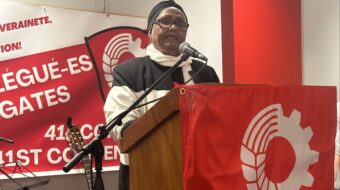
Much of West Africa continues to be dominated by the mechanisms of global neocolonialism. This neocolonialism is political (see the French hand in the murder of Burkinabé president Thomas Sankara, or the U.S. role in the coup against Ghanian president Kwame Nkrumah), economic (evidenced by Global North control over important regional industries), and monetary (France can unilaterally devalue the CFA franc, the currency of former French West African colonies which remains in use to this day).
But these are examples of overt neocolonialism, clear to anybody who reads West African history with a critical eye for Eurocentric myths. There is another country operating in West Africa whose malign influence is less obvious. Over the past few decades, this country has cashed in on the state of neocolonial dependency imposed by Europe and the United States by slyly increasing its economic hold over one of West Africa’s most valuable resources: gold. That country is Canada.
The Canadian mining industry is a global behemoth. Around 75% of mining companies are based in Canada, and Canada-based companies own majority shares in two of the three largest gold mines on the African continent (Loulo Gounkoto in Mali, owned 80% by Barrick Gold, and Fekola in Mali, owned 90% by B2Gold). Barrick also owns 45% of the single largest gold mine in Africa: Kibali in the Democratic Republic of Congo. Furthermore, mineral exploration is expanding across the continent, particularly in West Africa, a region which Bloomberg writer Felix Njini describes as “one of the last frontiers for gold-mining investors.”

In Burkina Faso, for example, Canadian companies already own half of all operational gold mines, while Vancouver-based Orezone Gold identifies 11 notable gold deposits which have yet to be exploited. Exploration missions are also increasing in southwest Mali and Senegal. The adverse effects of these mines—dispossession of locals, destruction of local economies, monitoring by private security, the spread of human trafficking in the form of child labor and forced prostitution—are ignored by both Canadian media and Canadian government development initiatives, which continuously implement programs intended to assist in the growth of the mining industry.
The Canadian Investment Fund for Africa (CIFA) is the largest initiative of the Canada Fund for Africa program, which was established as part of Canada’s role in the G8’s 2003 Africa Action Plan. The Canadian government has allocated around $100 million to CIFA, an investment which has generated “returns of capital and profits to Canada in excess of $30 million.” While the extraction of profit is not often associated with Canadian development initiatives, the sectors identified by the CIFA overview reveal that the primary goal of the program was not the fostering of African self-sufficiency, but in the Government of Canada’s own words, “privatization [of] business and other services (20.00%),” “industrial development (30.00%),” and “mineral prospection and exploration (30.00%).”
The CIFA was established in partnership with the CDC Group, the private equity “development finance institution” owned entirely by the government of the United Kingdom. It is a parastatal, or arms’ length, organization that was initially founded in 1948 by Prime Minister Clement Attlee under the name of the “Colonial Development Corporation.” In its early years, the CDC Group distributed funds for development projects in colonial Zambia, Botswana, and Kenya, and independent Indonesia, India, Pakistan, Ghana, and more.
The CDC Group’s investments in postcolonial territories are meant to generate return on investment for the British government, just as the U.K.’s formal colonial control over territories in the Global South was meant to create profit for the metropole. This reality is evidenced by several of the CDC Group’s most notable investments: privatized healthcare in India, privatized education across Africa, luxury apartments in Kenya, and palm oil plantations in the Democratic Republic of Congo which fail to provide their workers with “decent wages and services.” The CDC Group, which shares Canada’s interest in resource privatization across Africa, contributed around $60 million to the establishment of the CIFA.
Many Canadian development initiatives in the region, including the $20 million West Africa Governance and Economic Sustainability in Extractive Areas program (WAGES), are implemented in order to train local Africans in skills which they will need to work on sites owned by Canada-based mining companies, thereby increasing profits for these companies.

In discussions around Canadian overseas development policy, there is no questioning of the fact that Canada should and will promote mass privatization of African resources with the purpose of creating “returns of capitals and profits” for Canadian business. Programs like WAGES and CIFA may hide their neocolonial intentions more deftly than the Colonial Development Corporation, but their goals are the same: the weakening of African states and the strengthening of multinational business.
Token “corporate responsibility” initiatives are often implemented alongside these massive privatization programs. One such example is the Sahel and West Africa Club (SWAC) support program, which ran from 2006 to 2010 and contributed $4.5 million to the Paris-based Organization for Economic Co-operation and Development’s SWAC Secretariat. This program resulted in the creation of “an awareness tool for [multinational] companies about commercial pressures on land,” as though simply reminding these companies of their destructive environmental impact would cause them to limit their excesses. The program also claimed to “combat the child labour trade especially [in] its worst forms,” failing to recognize that the neocolonial underdevelopment paradigm from which Canadian companies are benefitting is what sustains the child labor trade, particularly in the mining sector.
These “corporate responsibility” programs are established with the purpose of branding Canadian development aid, which is almost always tied to trade liberalization in the targeted country, as progressive. Similarly, security collaborations with regional governments are meant to promote the image of Canada as an international peacekeeper while simultaneously stabilizing resource-rich regions for extractive investment. This was the case with the $3.5 million “Arms and Ammunition Management for More Stability in the Sahel Region” project. This project’s funds were given directly to the Mines Advisory Group with the goal of establishing security relationships with the authorities of Burkina Faso, Niger, and Mali, in order to limit the risk of violence in this growing center for the global gold industry.
The 2014 popular uprising against Burkinabé President Blaise Compaoré, maligned by the people of Burkina Faso but a close friend of Canadian mining companies, did not produce significant changes to the neocolonial relationship between the countries. A 2015 meeting between Prime Minister Justin Trudeau and new President Roch Marc Christian Kaboré reveals this. As Canadian mining investments in Burkina Faso and ALL of West Africa continue to rise—alongside “the increasing poverty of most of the population”—Kaboré shook hands with Trudeau and “underscored the importance of Canadian investments to Burkina Faso’s economy.”










